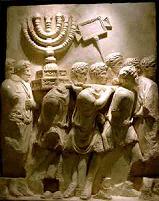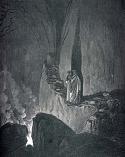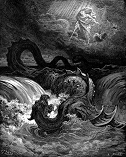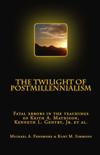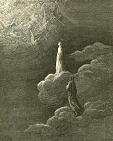The Consummation of the Pre-Messianic Age
and the Parousia of Christ
Excerpts from Biblical Apocalyptics
by
Milton S. Terry
(A.D. 1898)
It remains to notice a few things peculiar to Matthew's report of this discourse of Jesus. According to his gospel the form of the disciples' question was, "When shall these things be, and what shall be the sign of thy coming (parousia) and of the consummation of the age (sunteleia tou aionos)?" They seem to have already inferred or assumed that his coming and the consummation of the age would be connected in some way with the desolation of the temple. The closing words of chap. xxiii were of a nature to imply all this [1] If it were not to be, and Jesus knew it, it is inconceivable that he should have confirmed them in such a belief as the language of Matt. xxiv was certainly adapted to do. What significance, then, are we to attach to the words coming, and consummation of the age?
The words parousia, commonly translated coming, is so constantly associate, in current dogmatics, with the ultimate goal of human history, that ordinary readers lose sight of its simple meaning in New Testament usage. The word means presence as opposed to absence. For example, we read in Phil. ii,12, "Sop then, my beloved, even as ye have always obeyed, not as in my presence (en te parousia mou) only, but now much more in my absence (en te apousia mou), work out your own salvation with fear and trembling." But as the personal presence of any one implies a previous coming, so this word is not improperly rendered coming in many passages, and the verb erchomai, to come, is often employed to denote the appearance and kingdom of Christ. [2] Bt to assume that this coming or presence of Christ must needs be spectacular in any physical sense, a literal display of his person in the atmosphere of this earth, is to involve the doctrine in great confusion. Why must the coming of the Son of man on the clouds to execute judgment on that generation be understood or explained in any other way than we explain Jehovah's "riding upon a swift cloud," and coming to execute judgment on Egypt, as prophesied in Isa. xix,1? Whatever the real nature of the parousia, as contemplated in this prophetic discourse, our Lord unmistakably associates it with [p. 245] the destruction of the temple and city, which he represents as the signal termination of the pre-Messianic age. The coming on clouds, the darkening of the heavens, the collapse of the elements, are, as we have shown above, familiar forms of apocalyptic language, appropriated from the Hebrew prophets. [3]
That other expression in Matthew, "the consummation of the age," is a phrase that has been much abused and widely misunderstood. The common translation, "end of the world," has been a delusion to many readers of the English Bible. It has helped to perpetuate the unscriptural nation that the coming and kingdom of Christ are not facts of the past, present, and future, but of the future only. The fundamental and distinguishing doctrine of all branches of the "Adventists," so-called, is that the coming of the Son of man to set up his kingdom is this world is solely an event of the future. Christ has as yet no kingdom among men! Even the parables of our Lord, illustrative of the spiritual character of the kingdom, are forced to harmonize with the concept of a spectacular advent and a political organization. [4] Those who maintain the doctrine, and, indeed, not a few who oppose it, fall into error and inconsistency by failing to apprehend the true meaning of the phrase "the end of the age."
For, first of all, they do not determine clearly what age (aion) is contemplated in such a text as Matt. xxiv,3. They quite generally assume that the period of the Gospel dispensation is meant. But nothing is more familiar in the Jewish terminology of our Lord's time than the current phrases this age and the age to come. The period which preceded the coming of the Messiah [p. 246]was spoken of as this age; that which followed his coming was the age to come.[5] It is not important to consider what various and often contradictory notions the rabbins associated with the age to come. Their notions were as various as those concerning the character of the Messiah himself. But by this age they meant and could mean nothing else than the current period in which they were living, the then present age. The question of the disciples, as recorded, could therefore only refer to the pre-Messianic age, and its consummation was, as we have seen, associated in their thought with the overthrow of the temple. But even were it admitted that their nation of the "consummation of the age" was erroneous, the teaching of Jesus was emphatic beyond all rational question that that generation should not pass away before all those things of which they inquired should be fulfilled.
The age to come, the Messianic time, would accordingly be the period that would follow immediately after the termination of the pre-Messianic age. that time had not yet come when Jesus spoke. According to the whole trend of New Testament teaching that age and the Messianic kingdom were near or at hand. Christ's ministry fell in the last days of an aion. The gospel of his kingdom must be firmly established in the world before the end of that age. The gospel of his kingdom must be firmly established in the world before the end of that age. So we read, in Heb. ix, 26: "Now, once, at the end of the ages (epi sunteleia ton aionon) hath he been manifested to put away sin by the sacrifice of himself." Also in Heb. i, 1, it is written: "God...hath at the last of these days spoken unto us in his Son." Similarly Peter (1 Pet. i, 20) speaks of Christ as "foreknown before the foundation of the world, but manifested at the end of the times for your sake." Paul, too, speaks of himself as living near the consummation of an age: "These things happened unto them by way of example; and they were written for our admonition upon whom the ends of the ages are come" (1 Cor. x,11) The ministry both of Jesus and his disciples must, therefore, be recognized as occurring in the latter days of an aion, or near the end of the pre-Messianic age. The New Testament writers, as well as Jesus, are clear on this point. They never represent themselves as already entered upon the first days, or the beginning of the age, but rather in the last days.
If, now, we ask with the disciples, WHEN shall these things be? or at what point are we to recognize the end of the pre-Messianic age? we are to find the answer in the eschatological discourse of [p. 248] Jesus, and at some point before that generation passed away. "The ends of the ages" may have a definite point of contact and transition from one age to another. The coming age may, like the morning twilight, cast its beams into the foregoing night, and so the preceding age may partake in its last days of many things which belong to the age to come. [6] But such facts do not affect the question of the signal crisis which may conspicuously mark the end of one age and the opening of another. Was there such a crisis between the Jewish and Christian dispensations, that we can point to it and say, "That was preeminently and conspicuously an event which marked an epoch in the history of both Judaism and Christianity?"
Some writers find such a crisis or end in the crucifixion of Jesus, and the moment when he said, "It is finished." (tetelestai). Others say it was at the resurrection; some few designate the ascension; but many have taught that the outpouring of the Spirit on the day of Pentecost was the coming of Christ in his kingdom, the end of the old and the beginning o the new age. To all of these theories there are two insuperable objections: (1) They are irreconcilable with the statement of Jesus that the Gospel must first be preached "in all the habitable earth" (oikonmene), and (2), long after the day o f Pentecost, the apostles speak of their work as taking place in the last days, or near the end of the age.
Is it not strange that any careful student of our Lord's teaching should fail to understand his answer to this very question? The disciples asked, definitely, WHEN shall it be? And Jesus proceeded to foretell a variety of things which they would live to see - all preliminary to the end. He foretold the horrors of the siege of Jerusalem, and an intelligible sign by which they might know the imminence of the final catastrophe of Judaism. And having told them of all these things, and of his own coming in the clouds and its glorious significance, he added: "When ye see these things coming to pass, know that it is nigh, at the door. Verily I say unto you, this generation shall not pass away until all these things be accomplished." The ruin of the temple was, accordingly, the crisis which marked the end of the pre-Messianic age. [p. 249]
Matthew's gospel appends to the eschatological discourse three parables of admonition, which occupy the whole of the twenty-fifth chapter. The parable of the ten virgins and the picture of the judgment are peculiar to this gospel, but the parable of the talents appears to be in substance identical with that of the pounds (mnas, minas) in Luke xix, 11-27. The three parables as they stand in Matthew, whether originally uttered in this connection or not, are every way appropriate to the context. They are admonitions to watch and be ready for the coming of the Lord, and are not essentially different from the counsels already noticed in the fourth section of the preceding discourse (for example, Matt. xxiv, 32-51). The lesson of the parable of the virgins is, "Watch, therefore, for ye know not the day nor the hour." The great lesson of the parable of the talents is that the Lord's servants have also something more to do than merely to watch. They must be diligently employed in the service and interests of their owner during his temporary absence from them, whether the time be long or short. There is, then, no difficulty as to the import of these parables, and no question as to their relevancy to the subject of which Jesus spoke on the Mount of Olives.
Greater difficulty is supposed to attach to the sublime picture of Judgment recorded in Matt. xxv.31-46, and most expositors have thought that the picture must needs refer to a general and formal judgment of all nations of men at the conclusion of human history. But the language of Matthew is explicit in referring it to the time "when the Son of man shall come in his glory, and all the angels with him," and when "he shall sit on the throne of his glory." There would be obvious inconsistency in making this coming of the Son of man different from that of matt. xxiv, 30, and xvi, 27,28. How, then, it is asked, can this sublime ideal be brought within the time-limits of the prophecy of matt. xxiv?
The difficulties which are here suggested arise either from the assumptions of a literalizing exegesis or from a failure to keep in mind that the coming and kingdom of Christ are in their nature a process, which has definite historical beginning, but stretches on indefinitely into future ages of ages. Consequently, while most of the things enumerated in the foregoing discourse had fulfillment in the fall of Judaism and the beginning of Christianity, other things, from their very nature, are such as must needs be of repeated or continual occurrence. Such especially is the execution of judgment, a function of every reigning king. The scriptural doctrine of Messiah's reign is not that God, the father Almighty, vacates his throne at the accession of Christ. Neither the concept of Psalm ii, [p. 250] 7-9, nor Psalm cx, nor Dan. vii, 13,14, implies that the eternal God is any less the ruler and sovereign of the world after he sets his anointed Son at his right hand, and "gives him dominion and glory and a kingdom." From thence onward he judges the world by Jesus Christ, and the sublime picture of Matt. xxv, 31-46, is a parable of this great fact. Hence the force and propriety of the words: When the Son of man shall come in his glory, and all the angels with him, then shall he sit on the throne of his glory." But how long he shall continue to sit thus on his glorious throne of judgment - how long "he must reign until he hath put all enemies under his feet" - is not a matter of specific revelation. The ideal of judgment presented in Matt. xxv, 31-46, is therefore no single event, like the destruction of Jerusalem. It is not to be explained literally as a formal assize not to open until the end of human history on earth. It is, rather, a most impressive parabolic picture of the age-long administration of Jesus Christ, form the hour of the signal overthrow of Jerusalem until "he shall deliver up the kingdom to the Father" (1 Cor. xv, 24). the anointed King of glory is judge of the living as well as of the dead, and it is a grave error to represent "the day of the Lord" or "the day of judgment" as something deferred to the end of time. We have shown over and over again in the preceding portions of this volume that "the great and terrible day of the Lord " is a prophetic phrase of remarkable fullness of meaning. The Old Testament doctrine is that "the kingdom is Jehovah's, and he is ruler among the nations" (Psalm xxii, 28). "Say ye among the nations, Jehovah reigneth; he shall judge the peoples with equity. he cometh, he cometh to judge the earth; he shall judge the world in righteousness, and the peoples in his truth" (Psalm xcvi, 10-13. The day of judgment for any wicked nation, city, or individual is the time when the penal visitation comes; and the judgment of God's saints is manifest in every signal event which magnifies goodness and condemns iniquity.[7] [p. 251]
But this divine administration of the world, which in the Hebrew Scriptures is the work of Jehovah, is portrayed in Dan. vii, 13,14, and represented in the New Testament as committed unto Christ. The Father has given him "authority to execute judgment because he is Son of man" (John v, 27). And the Son of man came, in accord with the apocalyptic pic5ture of Dan. vii, 13, and Matt. xxiv, 30, and executed judgment upon Jerusalem, guilty of "all the righteous blood shed upon the earth, form the blood of Able the righteous unto the blood of Zachariah" (Matt. xxiii, 35,36). That was the first conspicuous exhibition of his judicial power, and it marked the crisis and end of the pre-Messianic age. Christ is, therefore, now King and Judge; but all things are not yet subjected unto him, and he must reign until he shall have put all things in subjection under his feet. And this no other than the decree,
Jehovah has said to me, My Son art thou; I have this day begotten thee. Ask from me, and I will give nations for thine inheritance, And for thy possession the ends of the earth Psalm ii, 7,8.
We conclude, then, that the additions peculiar to Matthew's version of our Lord's discourse on the Mount of Olives contain nothing inappropriate to the occasion, and nothing inconsistent with the definite time-limit of the prophecy and the analogy of New Treatment eschatology. [p. 252]
Notes
(Editor's note: the following notes appeared at the foot of the page where they are cited and should be referenced accordingly.)
[1] "the disciples assume as a matter of course," says Meyer, "that immediately after the destruction in question the Lord will appear, in accordance with what is said in xxiii, 39, for the purpose of setting up his kingdom, and that with this the current (the pre-Messianic) era of the world's history will come to an end." - Critical and Exegetical Handbook on Matthew, in loco.
[2] Comp. Matt xvi, 27,28; xxiv, 30; xxv, 31; John xiv, 3; Rev. 1, 7; xxii, 7.
[3] Acts i, 11, is often cited to show that Christ's coming must needs be spectacular, "in like manner as ye beheld him going into the heaven." But (1) in the only other three places where on tropon, what manner, occurs, it points to a general concept rather than the particular form of its actuality. Thus, in Acts vii, 28, it is not some particular manner in which Moses killed the Egyptian that is notable, but rather the certain fact of it. In 2 Tim. iii, 8, it is likewise the fact of strenuous position in Matt. xxiii, 37, and Luke xiii, 34, it is the general thought of protection rather than the visible manner of a mother bird that is intended. Again (2), if Jesus did not come in that generation, and immediately after the great tribulation that attended the fall of Jerusalem, his words in Matt. xvi, 27,28, xxiv, 29, and parallel passages are in the highest degree misleading. (3) To make the one statement of the angel in Acts i, 11, override all the saying of Jesus on the same subject and control their meaning is a very one-sided method of biblical interpretation. but all the angel's words necessarily mean is that as Jesus has ascended into heaven so he will come from heaven. And this main thought agrees with the language of Jesus and the prophets.
[4] See, for example, the excursus of Dr. E.R. Craven on the Basileia in the American edition of Lange's Commentary on the Revelation of John, pp. 93-100.
[5] See Schurer, History of Jewish People in the Time of Jesus Christ, English translation, vol. ii, p. 177; Schoettgen, Horae Hebraicae, i,, 1153-1158.
[6] And so we should note that many things which Jesus spoke by way of counsel and admonition are as applicable to one period as another. The exhortation to watch, which having a special historical motive and force with the disciples, has its abiding lesson as one of the things ever incumbent upon the servants of the heavenly King. So many particular exhortation and counsels of Old Testament prophets have permanent value. It is in this way that the scriptures of both Testaments are profitable for instruction in righteousness.
[7] We need not assume to say how far and in what manner Christ executes his judgments or gathers his elect by the ministry of angels. He who "makes the clouds his chariot, who walks upon the wings of the wind, making his angels winds, and his ministers a flame of fire" (Psalm civ, 3,4; comp. Heb 1, 7), is present in all the great crises of this world's history, and he makes his angels ministering spirits to serve such as are to inherit salvation (Heb. 1,14). Our Lord represented Lazarus as carried away (apevexthenai) by the angels into Abraham's bosom (Luke xvi, 22). But there is no warrant in Scripture for the nation that when the angels are sent forth on missions of mercy or of judgment their operations must needs be visible to mortal eyes. When the impious Herod Agrippa allowed himself to be honored as a god, "immediately an angel of God smote him, and, becoming eaten of worms, he breathed out his spirit" (Acts xii, 22,23). Human eyes saw nothing but the curse of a foul disease, or a terrible plague; but Scripture sees back of it the potent ministry of a destroying angel (comp. Exod. xii, 23; 2 Sam. xxiv, 16). So the visible effects of divine judgment were terribly manifest in the unparalleled miseries of Jerusalem. The righteous blood of unnumbered martyrs was visited upon that generation (Matt. xxiii, 35,36); and where the Jewish historian saw and made record of appalling tribulation and woe the word of prophecy discerned a "revelation of the Lord Jesus from heaven, with the angels of his power [personal or natural] in flaming fire, rendering vengeance to them that know not God, and to them that obey not the Gospel" (2 Thess. 1, 7,8). In like manner the King of glory is continually judging and reigning among the nations, and he will not cease from his age-long work until " he shall have abolished all rule and authority and power" (1 Cor. . xv, 24).
To receive Kurt Simmons’ e-mail newsletter, The Sword & The Plow, click the Subscribe link:
All rights reserved.
